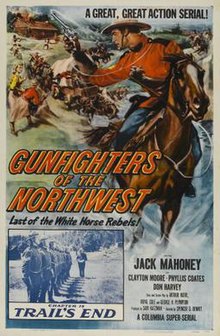Gunfighters of the Northwest
| Gunfighters of the Northwest | |
|---|---|
 | |
| Directed by | Spencer Gordon Bennet Charles S. Gould |
| Written by | Royal K. Cole Arthur Hoerl George H. Plympton |
| Produced by | Sam Katzman |
| Starring | Jock Mahoney Clayton Moore Phyllis Coates Don C. Harvey Marshall Reed Rodd Redwing Lyle Talbot |
| Cinematography | William Whitley - B&W |
| Edited by | Earl Turner |
| Music by | Mischa Bakaleinikoff |
| Distributed by | Columbia Pictures |
Release date |
|
Running time | 15 Episodes, 97 minutes |
| Country | United States |
| Language | English |
Gunfighters of the Northwest (1954) was the 53rd serial released by Columbia Pictures. It was entirely filmed on location at Big Bear Lake, California, USA, and not a single scene was filmed in indoors setting.
Plot
White Horse Rebels, under the command of a mystery villain known only as The Leader, attempt to create an independent "White Horse Republic" in Canada's north west. Funded by gold from the Marrow Mine, they attack Canadian settlements in the area. The North-West Mounted Police, represented primarily by hero Sgt. Ward and his sidekick Constable Nevin are, work to top the rebels and discover The Leader's real identity. An added complication comes in the form of First Nations, Blackfeet driven into Canada from the United States, who attack both sides and whom the rebels attempt to use as scapegoats for their own attacks.
Production
The entire filming of Gunfighters of the Northwest took place outdoors at Big Bear Lake, California. Even a scene set in a cave was filmed outside with director Spencer Gordon Bennet setting up the lighting and a back grop to make it appear to be an internal shot.[1] During filming, the whole cast and crew all lived at a nearby hotel.[1]
The two heroic leads, Jock Mahoney and Clayton Moore, were injured during production. On the second day of shooting, Moore's horse backed and threw him. He landed on his back and was knocked unconscious. An assistant director took him to a doctor in Big Bear, who said he would be "laid up for a little while", after which Moore visited a chiropractor in town, who was able to help him. He was not able to perform any rising scenes for a few days but could act in all the dramatic scenes with no problems.[1] Mahoney was hurt on the same day, injuring a metatarsal in a fight scene, but he was able to walk and continue filming the next day.[1]
Moore had been the Lone Ranger in the television series until being replaced by John Hart in 1952. Hart was at that time dating female lead Phyllis Coates and visited the set. When Moore was injured, the production needed a double to stand in for him in a riding scene and Hart volunteered. Hart ended up doubling for Moore in several scenes in the serial.[1]
Cast
- Jock Mahoney as North-West Mounted Police (NWMP) Sergeant Joe Ward
- Clayton Moore as NWMP Constable Bram Nevin
- Phyllis Coates as Rita Carville, undercover agent
- Don C. Harvey as Otis Green, trading post proprietor
- Marshall Reed as Gale Lynch, commander of the White Horse Rebels and spearpoint heavy for The Leader
- Rodd Redwing as Bear Tooth, aggressive Blackfoot
- Lyle Talbot as NWMP Inspector Wheeler
- Tommy Farrell as NWMP Constable Arch Perry
- Lee Roberts as Arnold Reed, Indian Agent
- Terry Frost as Wildfoot, half-Indian agent of the NWMP
- Joseph Allen, Jr. as Fletcher Stone
- Gregg Barton as Hank Bridger, a White Horse Rebel
- Chief Yowlachie as Running Elk, chief of the Blackfeet
- Pierce Lyden as Dakota, a White Horse Rebel
- William Fawcett as a miner and guard of the Marrow Mine
- John Hart as NWMP Sergeant Dan Wells
- Kermit Maynard as a mountie
Chapter titles
- A Trap for the Mounties
- Indian War Drums
- Between Two Fires
- Midnight Raiders
- Running the Gauntlet
- Mounties at Bay
- Plunge of Peril
- Killer at Large
- The Fighting Mounties
- The Sergeant Gets His Man
- The Fugitive Escapes
- Stolen Gold
- Perils of the Mounted Police
- Surprise Attack
- Trail's End
Source:[2]
See also
References
- ^ a b c d e Moore, Clayton (1998). I Was That Masked Man. Taylor Trade Publishing. pp. 138–140. ISBN 9781461625155.
- ^ Cline, William C. (1984). "Filmography". In the Nick of Time. McFarland & Company, Inc. pp. 254–255. ISBN 0-7864-0471-X.
